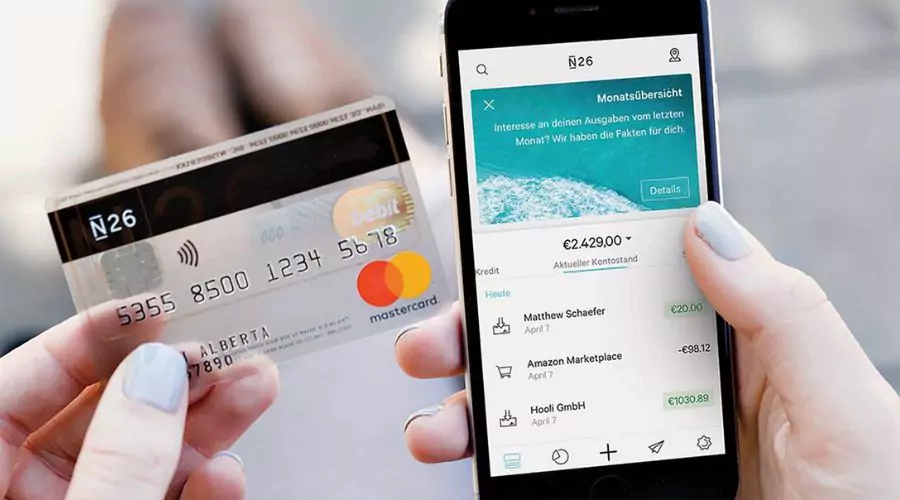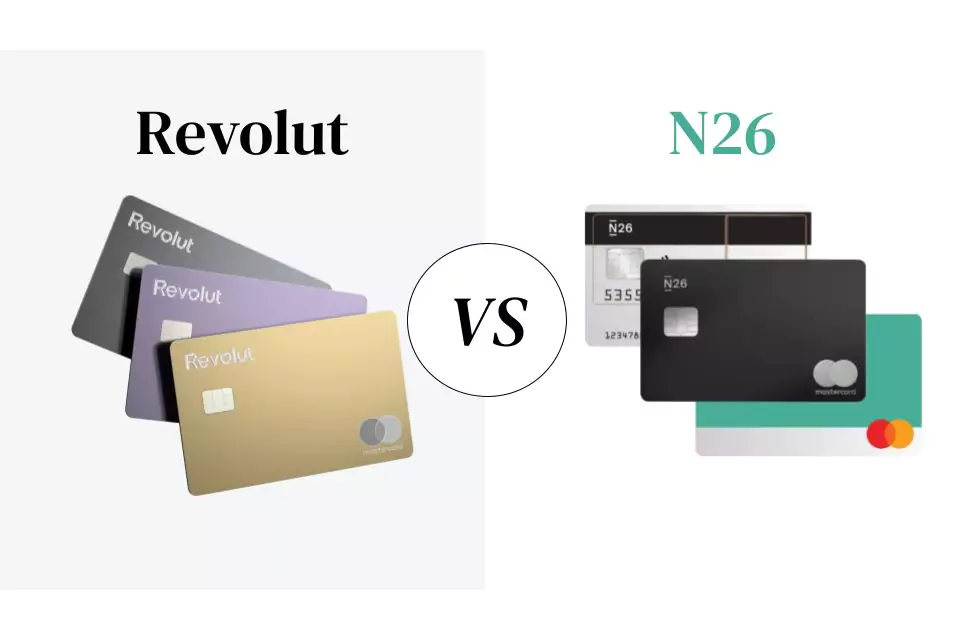In this digital age, having a reliable digital bank to support you is extremely important. Whether you want to make international transactions, travel abroad, or need day-to-day banking services, platforms like Revolut and N26 take care of all your needs. This brings us to the question which one is better? Well, that’s why we are here—to unravel what they offer and what they don’t! Our aim is to decipher which one rules over the other in terms of accessibility, security, international transfers, day-to-day banking, and more. Let’s get started with the Revolut VS N26 comparison!
What is Revolut?

Revolut is a groundbreaking fintech company that has redefined the way people manage their finances in the digital age. Established in 2015, Revolut has rapidly grown to become one of the most prominent names in the global banking and financial technology sectors. With over 25 million customers worldwide and a presence in more than 35 countries, Revolut has built a reputation for its innovative approach to banking services and its commitment to delivering financial empowerment to individuals around the world. Revolut offers a diverse range of financial products and services designed to meet the evolving needs of its customers, including multi-currency accounts, investments, savings, business solutions, day-to-day business services, money transfers, security, and more.
What is N26?

N26, founded in Berlin in 2013, is revolutionizing traditional banking with a strong focus on customers. It offers a suite of digital banking services accessible through its user-friendly mobile app and website. Operating across Europe and the United States, N26 provides borderless banking solutions, harnessing technology for real-time notifications, innovative budgeting tools, and robust security measures. The bank is committed to transparency, sustainability, and fair pricing, making banking simpler and more accessible for everyone.
Revolut VS N26: A Detailed Comparison
Revolut VS N26: Pricing Overview
| Bank | Plan | Price | Features |
| Revolut | Standard | Free |
|
| Plus | £2.99/month | Everything in the Standard plan, plus:
|
|
| Premium | £6.99/month | Everything in the Plus plan, plus:
|
|
| Metal | £12.99/month | Everything in the Premium plan, plus:
|
|
| Ultra | £45/month | Everything in the Metal plan, plus:
|
|
| N26 | Standard | Free |
|
| Smart | €4.90/Month | Everything in the Standard plan, plus:
|
|
| You | €9.90/Month | Everything in the Smart plan, plus:
|
|
| Metal | €16.90/Month | Everything in the You plan, plus:
|
As you can see, the pricing of Revolut and N26 is very similar. Both banks offer a free plan with basic features and then charge a monthly fee for plans with additional features. The main differences between the two banks are:
- Revolut offers travel insurance and mobile phone insurance on its Plus plan, while N26 only offers these on its You plan.
- Revolut offers 1% cashback on select purchases on its Plus plan, while N26 offers 1% cashback on all purchases on its Smart plan.
- Revolut offers a metal debit card on its Metal plan, while N26 offers this on its You plan.
Revolut VS N26: Setting up your account
Both N26 and Revolut offer a streamlined process for opening an account online via your smartphone. Here’s a straightforward guide for both banks:
- App Download: Begin by downloading the N26 or Revolut mobile app from your smartphone’s app store.
- Personal Information: Upon app installation, you will need to input personal details, which typically include your full name, address, date of birth, and contact information.
- Identity Verification: To confirm your identity, you’ll be prompted to capture a photo of your passport using your smartphone’s camera. This step ensures proper identity verification.
- Selfie Confirmation: Subsequently, you’ll be asked to take a selfie using your phone’s camera. This selfie is used for facial recognition and additional identity verification.
- Submission Through the App: After completing the personal information, providing a picture of your passport, and taking a selfie, proceed to submit this data directly through the app.
- Account Setup: If all the provided information checks out and is in compliance with the bank’s requirements, your account will be set up. You’ll receive an IBAN (International Bank Account Number) and a BIC (Bank Identifier Code) almost immediately.
- Physical Card (Optional): If you wish to have a physical debit card, you can request one. N26 charges €10 for this service, while Revolut charges €6. The card will be sent to your registered address and typically arrives within a week. However, you can start using your account for payments immediately through the app.
Revolut VS N26: Topping up your account
Both N26 and Revolut offer options for funding your account. When it comes to Revolut, you can easily link your main bank’s debit card to your Revolut account, allowing you to transfer money almost instantly within the Revolut app. Be aware that your main bank may charge fees for this transaction.
You can also deposit money into your Revolut account using a traditional bank transfer. This involves using your Revolut IBAN and BIC. There are usually no fees from Revolut for this, but again, your main bank might charge fees on their end.
As for N26, you can fund your N26 account through a regular bank transfer. Like with Revolut, your main bank may charge fees for this transfer. N26 allows your first instant top-up within the app to be free of charge. However, subsequent instant top-ups will incur a 3% fee. This is where Revolut gets the upper hand on N26.
Revolut VS N26: Day-to-day banking
Both N26 and Revolut offer free day-to-day banking services with no monthly or annual maintenance fees. Key features include:
- Transaction Fees: There are no charges for chip and pin or contactless transactions, standing orders, or direct debit payments.
- ATM Withdrawals (N26): N26 provides three free ATM withdrawals per month, with a €2 charge per withdrawal after the limit. On the other hand, Revolut allows up to €200 in fee-free ATM withdrawals per month, but only five free withdrawals. After reaching the limits, a €1 or 2% fee applies, whichever is higher.
- Digital Wallet Support: Both N26 and Revolut support popular digital wallets like Apple Pay and Google Pay.
Revolut VS N26: Travelling abroad
When you travel abroad, your bank acts as a reliable partner. Both N26 and Revolut offer competitive rates for foreign transactions, making them attractive for travellers. N26 charges no foreign exchange fees. Revolut, too, charges no fees on major currencies up to €1,000 per month; a 0.5% fee applies after that.
Revolut VS N26: Security
Both N26 and Revolut offer robust security features to make sure you enjoy a safe banking experience. They both use face and fingerprint recognition for secure login. You can even temporarily freeze your card within the app and unfreeze it if found, avoiding the need to cancel it.
The banks allow you to disable online transactions while still allowing in-store and ATM payments. Revolut even offers disposable virtual cards for secure online shopping, which automatically expire after use. On the other hand, N26 offers a virtual card for premium account holders.
Revolut VS N26: Other Features
Apart from the above-mentioned services, there are some other essential features that can enhance your overall experience. Here is a comparison of Revolut VS N26 based on these additional features:
- Savings Features: Both banks offer savings features. Revolut’s “Vaults” rounds up transactions and saves the difference. N26 has a similar “Round-Ups” feature for premium accounts.
- Cryptocurrencies: Both banks provide access to cryptocurrencies such as Bitcoin.
- Rewards Programs: N26 and Revolut offer rewards programs for discounts and cashback.
- Budgeting Tools: Both banks provide tools for budgeting, spending notifications, and tracking expenses.
- Split Bill Feature (Revolut): Revolut offers a convenient split bill feature for sharing expenses with contacts.
- Money Transfer Services: Both banks allow easy money transfers to other users, even if you don’t know their bank details.
Also Read – All you need to know about Samsung Galaxy Z Flip 5 2023
Conclusion
Our comprehensive comparison of Revolut VS N26 has shown us that both digital banks give tough competition to each other. Whether it’s the ease with which you can set up an account and top it up, day-to-day services, money transfers, or security, Revolut and N26 both have a lot to offer. As a final verdict, if you are looking for a more comprehensible banking experience with fewer fees and charges, then Revolut is the best option for you. It’s interface is easy to use and can even be fun. On the other hand, N26 provides more flexibility if you often make money transfers. In the end, both digital banks will not disappoint you. For such reviews and updates, visit Frontceleb.

